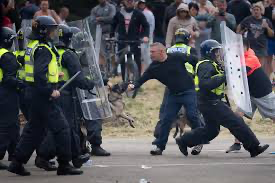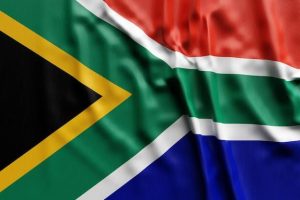
A Surge of Far-Right Violence: Britain’s Ongoing Unrest
Britain’s Unrest and Catalytic Incident
In recent days, Britain has been gripped by violent unrest, with disturbances breaking out across several towns and cities. The chaos reached new heights on Saturday as far-right agitators gathered for demonstrations nationwide. The catalyst for this surge in violence can be traced to a tragic event in Southport, a seaside town in northwestern England. On July 29, 2024, a brutal knife attack at a children’s dance and yoga class resulted in the deaths of three young girls. The suspect, 17-year-old Axel Rudakubana, a British-born youth of Rwandan descent, was quickly arrested and charged with their murders and ten counts of attempted murder for wounding eight other children and two adults.
The Spread of Misinformation
In the immediate aftermath of the attack, misinformation rapidly spread online, falsely claiming that Rudakubana was an undocumented migrant and a Muslim. This disinformation, propagated by far-right groups and individuals, fueled anger and mobilized supporters to take to the streets. Platforms such as Telegram and X (formerly known as Twitter) were instrumental in spreading these false narratives and organizing violent demonstrations.
Escalation of Violence
The violence began on the evening of July 30 in Southport, where over 200 people, many traveling from other parts of Britain, descended upon the town. The rioters attacked a mosque, injured more than 50 police officers, and set several vehicles ablaze. This was just the beginning of a series of violent events that spread across the country. The following day, clashes broke out in central London, leading to over 100 arrests. Similar incidents occurred in Hartlepool, Manchester, Aldershot, and Sunderland.
Government Response
Prime Minister Keir Starmer has condemned the violence, attributing it to far-right hatred rather than spontaneous protest. He announced a significant increase in police resources and the launch of the National Violent Disorder Program, which aims to improve intelligence sharing among police forces and utilize advanced technologies like facial recognition to quickly identify and apprehend rioters. This initiative is designed to allow police to respond swiftly and effectively to any further outbreaks of violence.
Continued Threats and Coordination
Despite the government’s efforts, the threat of further violence looms large. Demonstrations have been organized under slogans such as “enough is enough” and “stop the boats,” reflecting anti-immigrant and xenophobic sentiments. John Woodcock, the British government’s adviser on political violence and disruption, has noted a “concerted and coordinated” attempt by far-right actors to provoke violence in various towns and cities across the UK. These groups have adapted to new forms of mobilization, using social media to quickly organize and incite unrest..
Identifying the Agitators
Several far-right groups have been identified as instigators of the riots. David Miles, a notable member of the fascist group Patriotic Alternative, was seen in Southport, according to Hope Not Hate, an advocacy group monitoring extremist organizations. Other far-right agitators, including the neo-Nazi British Movement, used social media to spread information about the protests. Some participants bore Nazi tattoos. Post-Southport unrest, the police highlighted the involvement of English Defence League (EDL) supporters. The riots have also attracted individuals linked to soccer hooliganism, a long-standing companion of nationalist movements in Britain.
The English Defence League’s Legacy
The English Defence League (EDL), founded in 2009, emerged as a far-right street movement known for violent protests and a staunch anti-Islam, anti-immigration stance. The group originated in Luton in response to Islamic extremists’ abuse directed at returning British soldiers. Stephen Yaxley-Lennon, known as Tommy Robinson, was among its founders. Initially, the EDL carried out local demonstrations and provocative actions like placing pig heads around Muslim sites. Internal divisions eventually led to the group’s dissolution, though many former members remain active in other nationalist groups.
Challenges in Containing the Violence
Modern far-right groups in Britain often eschew traditional hierarchies and leadership structures, complicating efforts to combat them. Social media and other technologies facilitate activism beyond conventional organizational boundaries. Violent street rallies serve as effective recruiting tools for extremist groups. Law enforcement faces significant challenges in addressing rapidly mobilized mobs coordinated through private messaging apps. Professor Matthew Feldman noted, “Police are still often thinking in 20th-century terms—that something like this might take a few days to set up; that they might ask for a permit for a march.” The Southport riot, he added, “was very nearly a flash demo”.
Recent Developments
As of early August 2024, the situation remains tense. Several suspects involved in the violent protests have been arrested and are due in court. Prime Minister Starmer has reiterated his commitment to restoring order, emphasizing that the government will not tolerate the breakdown of law and order. Additional police officers have been deployed, and a comprehensive review of law enforcement strategies is underway to prevent further escalations.
The Path Forward
The recent events underscore the complex challenge of addressing far-right extremism in Britain. The government’s response involves not only immediate law enforcement measures but also long-term strategies to counteract the spread of misinformation and extremist ideologies. As Britain grapples with this surge in far-right violence, the need for a multifaceted approach that combines policing, community engagement, and digital regulation becomes increasingly clear.
In conclusion, the summer of unrest in Britain serves as a stark reminder of the persistent and evolving threat posed by far-right extremism. The government’s commitment to addressing this issue through enhanced law enforcement and strategic initiatives will be crucial in restoring peace and preventing future violence.
Riya Kothavale is a Research Fellow at the Sixteenth Council



